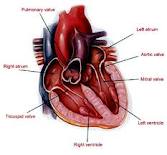Heart: Difference between revisions
No edit summary |
No edit summary |
||
| Line 1: | Line 1: | ||
[[Image:Heart.jpg|frame|right]] | [[Image:Heart.jpg|frame|right|Heart.jpg]] | ||
The heart is the | The heart is the driving force of the [[The Cardiovascular System|Cardiovascular System]] and is found in the human body in the left of the centre (between the [[Lungs|lungs]]). The heart function is to pump oxygenated [[Blood|blood]] around the body through arteries and to accept deoxygenated [[Blood|blood]] through the veins. These two processes are separated into the heart's left and right hand side respectively<ref>Parker S. (2007) The Human Body Book, 1st edition, London: Dorling Kindersley Limited.</ref> which are subdivided into four chambers <ref name="image">http://www.gknmhospital.org/ctvs/hevaldis.html</ref>. The Upper chambers are known as the [[Atria|Atria]], and the lower chambers are called [[Ventricles|ventricles]] <ref>http://inspirations786.wordpress.com/2011/11/15/four-chambers-of-heart-islamic-polygamy-of-up-to-four-wives-and-miracle-of-allah/</ref>. The wall separating the [[Ventricles|ventricles]] is known as the [[Ventricular septum|ventricular septum]] <ref>http://www.gknmhospital.org/ctvs/hevaldis.html</ref>. The heart is essentially a muscle. The ventricles have thick muscular wall in comparison the atria. This is because the ventricles are required to send the blood all round the body rather than just to the lungs. This requires a greater force, so hence more muscle is required to provide this. <ref>http://www.nhlbi.nih.gov/health/health-topics/topics/hhw/anatomy</ref> | ||
=== References: === | === References: === | ||
<references /><br> | <references /><br> | ||
Revision as of 13:52, 20 October 2015

The heart is the driving force of the Cardiovascular System and is found in the human body in the left of the centre (between the lungs). The heart function is to pump oxygenated blood around the body through arteries and to accept deoxygenated blood through the veins. These two processes are separated into the heart's left and right hand side respectively[1] which are subdivided into four chambers [2]. The Upper chambers are known as the Atria, and the lower chambers are called ventricles [3]. The wall separating the ventricles is known as the ventricular septum [4]. The heart is essentially a muscle. The ventricles have thick muscular wall in comparison the atria. This is because the ventricles are required to send the blood all round the body rather than just to the lungs. This requires a greater force, so hence more muscle is required to provide this. [5]
References:
- ↑ Parker S. (2007) The Human Body Book, 1st edition, London: Dorling Kindersley Limited.
- ↑ http://www.gknmhospital.org/ctvs/hevaldis.html
- ↑ http://inspirations786.wordpress.com/2011/11/15/four-chambers-of-heart-islamic-polygamy-of-up-to-four-wives-and-miracle-of-allah/
- ↑ http://www.gknmhospital.org/ctvs/hevaldis.html
- ↑ http://www.nhlbi.nih.gov/health/health-topics/topics/hhw/anatomy